Research Proposal: Employee Engagement's Role in Business Development
VerifiedAdded on 2023/01/05
|9
|2308
|35
Project
AI Summary
This research proposal investigates the crucial role of employee engagement in driving business development, specifically within the retail industry, with a case study on Hennes & Mauritz (H&M). The study aims to determine how employee engagement improves organizational competitiveness and contributes to overall success. The proposal outlines the background, research rationale, research questions, aims, and objectives, along with a detailed methodology. This includes the research philosophy (positivism), approach (deductive), strategy (quantitative survey), and choice (quantitative). Data collection methods, sampling techniques (probability sampling with a sample size of 30 employees), and ethical considerations are also addressed. The proposal further details the resources required, a timescale for completion, and a comprehensive list of references to support the research. The research intends to provide valuable insights into the benefits of engaged employees, such as increased productivity, improved organizational culture, and the achievement of business goals.
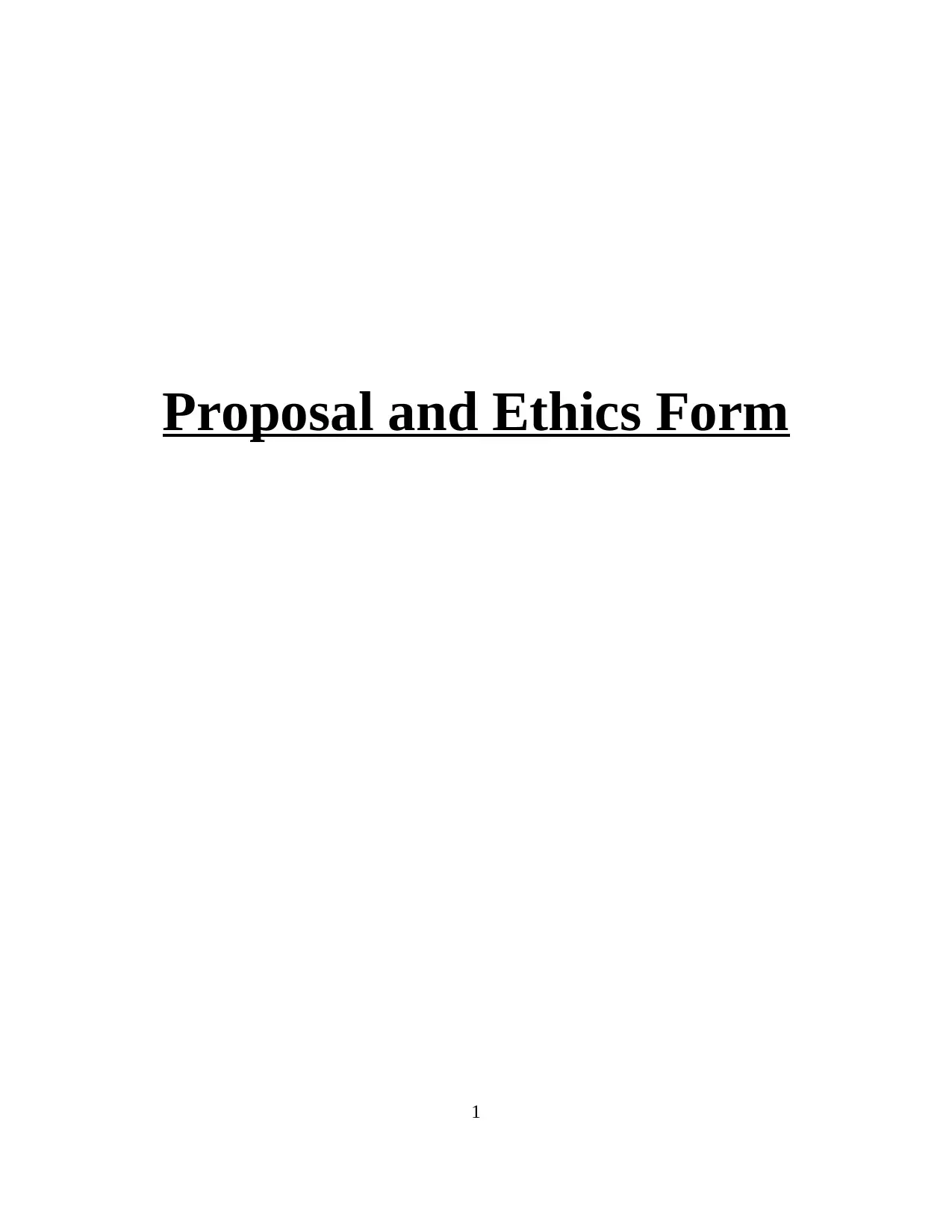
Proposal and Ethics Form
1
1
Paraphrase This Document
Need a fresh take? Get an instant paraphrase of this document with our AI Paraphraser
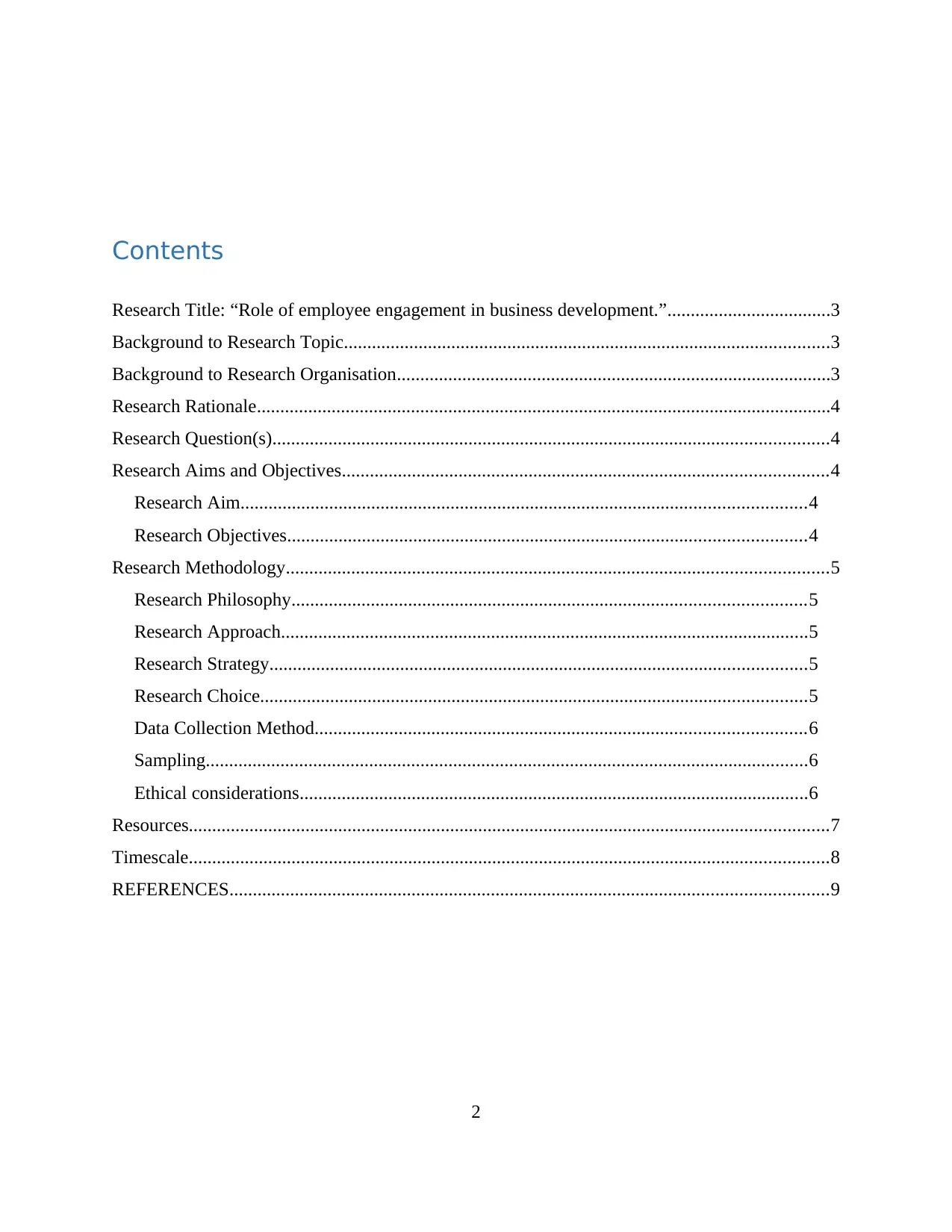
Contents
Research Title: “Role of employee engagement in business development.”...................................3
Background to Research Topic........................................................................................................3
Background to Research Organisation.............................................................................................3
Research Rationale...........................................................................................................................4
Research Question(s).......................................................................................................................4
Research Aims and Objectives........................................................................................................4
Research Aim.........................................................................................................................4
Research Objectives...............................................................................................................4
Research Methodology....................................................................................................................5
Research Philosophy..............................................................................................................5
Research Approach.................................................................................................................5
Research Strategy...................................................................................................................5
Research Choice.....................................................................................................................5
Data Collection Method.........................................................................................................6
Sampling.................................................................................................................................6
Ethical considerations.............................................................................................................6
Resources.........................................................................................................................................7
Timescale.........................................................................................................................................8
REFERENCES................................................................................................................................9
2
Research Title: “Role of employee engagement in business development.”...................................3
Background to Research Topic........................................................................................................3
Background to Research Organisation.............................................................................................3
Research Rationale...........................................................................................................................4
Research Question(s).......................................................................................................................4
Research Aims and Objectives........................................................................................................4
Research Aim.........................................................................................................................4
Research Objectives...............................................................................................................4
Research Methodology....................................................................................................................5
Research Philosophy..............................................................................................................5
Research Approach.................................................................................................................5
Research Strategy...................................................................................................................5
Research Choice.....................................................................................................................5
Data Collection Method.........................................................................................................6
Sampling.................................................................................................................................6
Ethical considerations.............................................................................................................6
Resources.........................................................................................................................................7
Timescale.........................................................................................................................................8
REFERENCES................................................................................................................................9
2
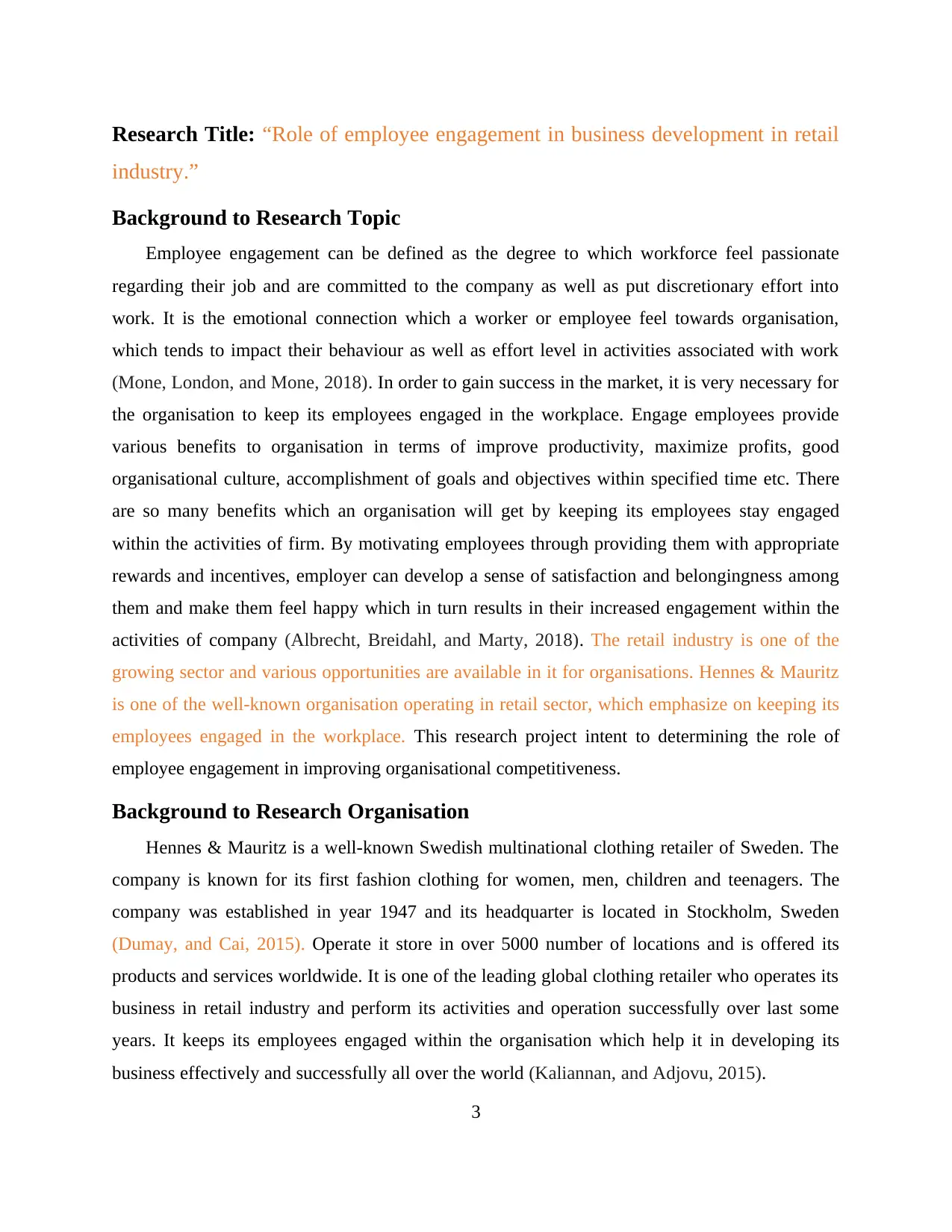
Research Title: “Role of employee engagement in business development in retail
industry.”
Background to Research Topic
Employee engagement can be defined as the degree to which workforce feel passionate
regarding their job and are committed to the company as well as put discretionary effort into
work. It is the emotional connection which a worker or employee feel towards organisation,
which tends to impact their behaviour as well as effort level in activities associated with work
(Mone, London, and Mone, 2018). In order to gain success in the market, it is very necessary for
the organisation to keep its employees engaged in the workplace. Engage employees provide
various benefits to organisation in terms of improve productivity, maximize profits, good
organisational culture, accomplishment of goals and objectives within specified time etc. There
are so many benefits which an organisation will get by keeping its employees stay engaged
within the activities of firm. By motivating employees through providing them with appropriate
rewards and incentives, employer can develop a sense of satisfaction and belongingness among
them and make them feel happy which in turn results in their increased engagement within the
activities of company (Albrecht, Breidahl, and Marty, 2018). The retail industry is one of the
growing sector and various opportunities are available in it for organisations. Hennes & Mauritz
is one of the well-known organisation operating in retail sector, which emphasize on keeping its
employees engaged in the workplace. This research project intent to determining the role of
employee engagement in improving organisational competitiveness.
Background to Research Organisation
Hennes & Mauritz is a well-known Swedish multinational clothing retailer of Sweden. The
company is known for its first fashion clothing for women, men, children and teenagers. The
company was established in year 1947 and its headquarter is located in Stockholm, Sweden
(Dumay, and Cai, 2015). Operate it store in over 5000 number of locations and is offered its
products and services worldwide. It is one of the leading global clothing retailer who operates its
business in retail industry and perform its activities and operation successfully over last some
years. It keeps its employees engaged within the organisation which help it in developing its
business effectively and successfully all over the world (Kaliannan, and Adjovu, 2015).
3
industry.”
Background to Research Topic
Employee engagement can be defined as the degree to which workforce feel passionate
regarding their job and are committed to the company as well as put discretionary effort into
work. It is the emotional connection which a worker or employee feel towards organisation,
which tends to impact their behaviour as well as effort level in activities associated with work
(Mone, London, and Mone, 2018). In order to gain success in the market, it is very necessary for
the organisation to keep its employees engaged in the workplace. Engage employees provide
various benefits to organisation in terms of improve productivity, maximize profits, good
organisational culture, accomplishment of goals and objectives within specified time etc. There
are so many benefits which an organisation will get by keeping its employees stay engaged
within the activities of firm. By motivating employees through providing them with appropriate
rewards and incentives, employer can develop a sense of satisfaction and belongingness among
them and make them feel happy which in turn results in their increased engagement within the
activities of company (Albrecht, Breidahl, and Marty, 2018). The retail industry is one of the
growing sector and various opportunities are available in it for organisations. Hennes & Mauritz
is one of the well-known organisation operating in retail sector, which emphasize on keeping its
employees engaged in the workplace. This research project intent to determining the role of
employee engagement in improving organisational competitiveness.
Background to Research Organisation
Hennes & Mauritz is a well-known Swedish multinational clothing retailer of Sweden. The
company is known for its first fashion clothing for women, men, children and teenagers. The
company was established in year 1947 and its headquarter is located in Stockholm, Sweden
(Dumay, and Cai, 2015). Operate it store in over 5000 number of locations and is offered its
products and services worldwide. It is one of the leading global clothing retailer who operates its
business in retail industry and perform its activities and operation successfully over last some
years. It keeps its employees engaged within the organisation which help it in developing its
business effectively and successfully all over the world (Kaliannan, and Adjovu, 2015).
3
⊘ This is a preview!⊘
Do you want full access?
Subscribe today to unlock all pages.

Trusted by 1+ million students worldwide
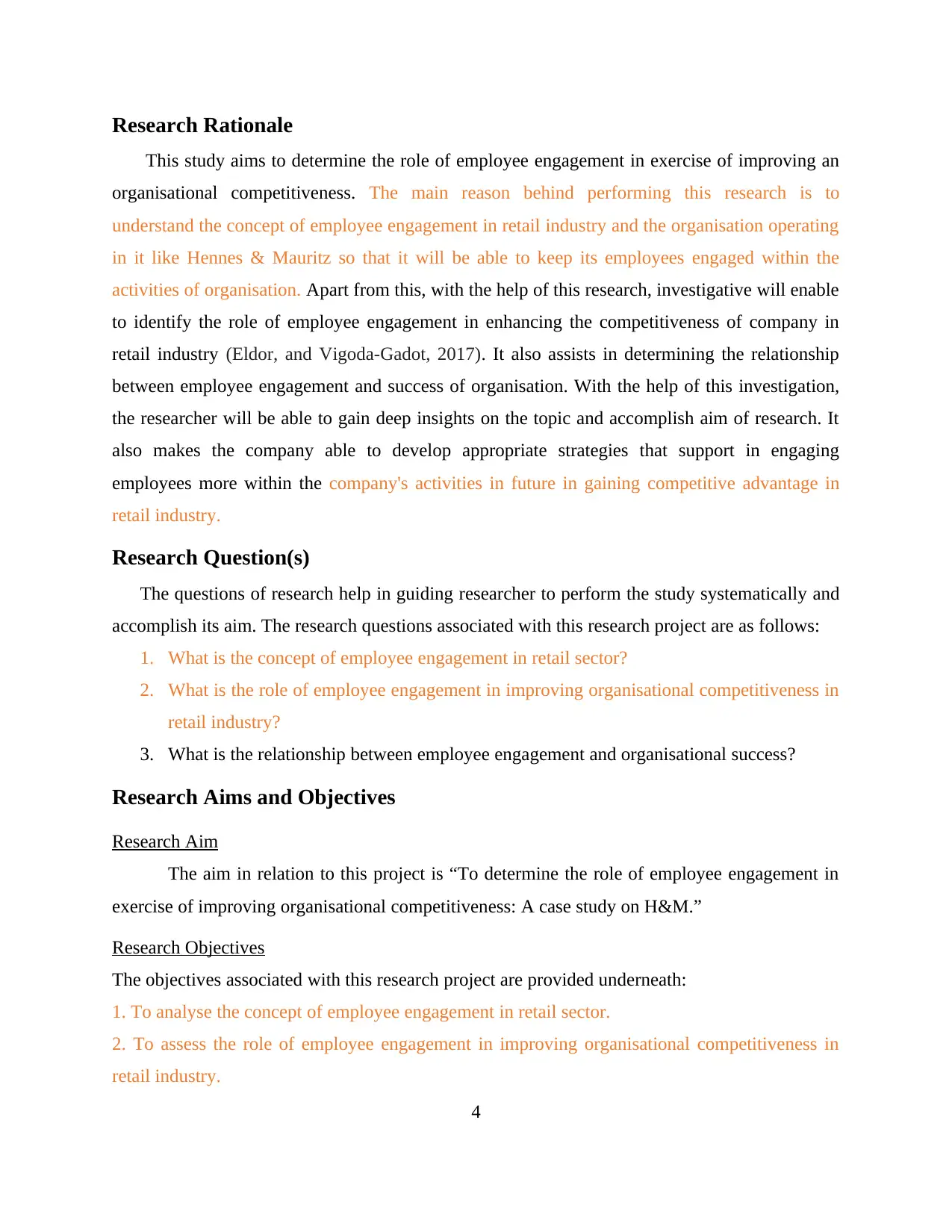
Research Rationale
This study aims to determine the role of employee engagement in exercise of improving an
organisational competitiveness. The main reason behind performing this research is to
understand the concept of employee engagement in retail industry and the organisation operating
in it like Hennes & Mauritz so that it will be able to keep its employees engaged within the
activities of organisation. Apart from this, with the help of this research, investigative will enable
to identify the role of employee engagement in enhancing the competitiveness of company in
retail industry (Eldor, and Vigoda-Gadot, 2017). It also assists in determining the relationship
between employee engagement and success of organisation. With the help of this investigation,
the researcher will be able to gain deep insights on the topic and accomplish aim of research. It
also makes the company able to develop appropriate strategies that support in engaging
employees more within the company's activities in future in gaining competitive advantage in
retail industry.
Research Question(s)
The questions of research help in guiding researcher to perform the study systematically and
accomplish its aim. The research questions associated with this research project are as follows:
1. What is the concept of employee engagement in retail sector?
2. What is the role of employee engagement in improving organisational competitiveness in
retail industry?
3. What is the relationship between employee engagement and organisational success?
Research Aims and Objectives
Research Aim
The aim in relation to this project is “To determine the role of employee engagement in
exercise of improving organisational competitiveness: A case study on H&M.”
Research Objectives
The objectives associated with this research project are provided underneath:
1. To analyse the concept of employee engagement in retail sector.
2. To assess the role of employee engagement in improving organisational competitiveness in
retail industry.
4
This study aims to determine the role of employee engagement in exercise of improving an
organisational competitiveness. The main reason behind performing this research is to
understand the concept of employee engagement in retail industry and the organisation operating
in it like Hennes & Mauritz so that it will be able to keep its employees engaged within the
activities of organisation. Apart from this, with the help of this research, investigative will enable
to identify the role of employee engagement in enhancing the competitiveness of company in
retail industry (Eldor, and Vigoda-Gadot, 2017). It also assists in determining the relationship
between employee engagement and success of organisation. With the help of this investigation,
the researcher will be able to gain deep insights on the topic and accomplish aim of research. It
also makes the company able to develop appropriate strategies that support in engaging
employees more within the company's activities in future in gaining competitive advantage in
retail industry.
Research Question(s)
The questions of research help in guiding researcher to perform the study systematically and
accomplish its aim. The research questions associated with this research project are as follows:
1. What is the concept of employee engagement in retail sector?
2. What is the role of employee engagement in improving organisational competitiveness in
retail industry?
3. What is the relationship between employee engagement and organisational success?
Research Aims and Objectives
Research Aim
The aim in relation to this project is “To determine the role of employee engagement in
exercise of improving organisational competitiveness: A case study on H&M.”
Research Objectives
The objectives associated with this research project are provided underneath:
1. To analyse the concept of employee engagement in retail sector.
2. To assess the role of employee engagement in improving organisational competitiveness in
retail industry.
4
Paraphrase This Document
Need a fresh take? Get an instant paraphrase of this document with our AI Paraphraser
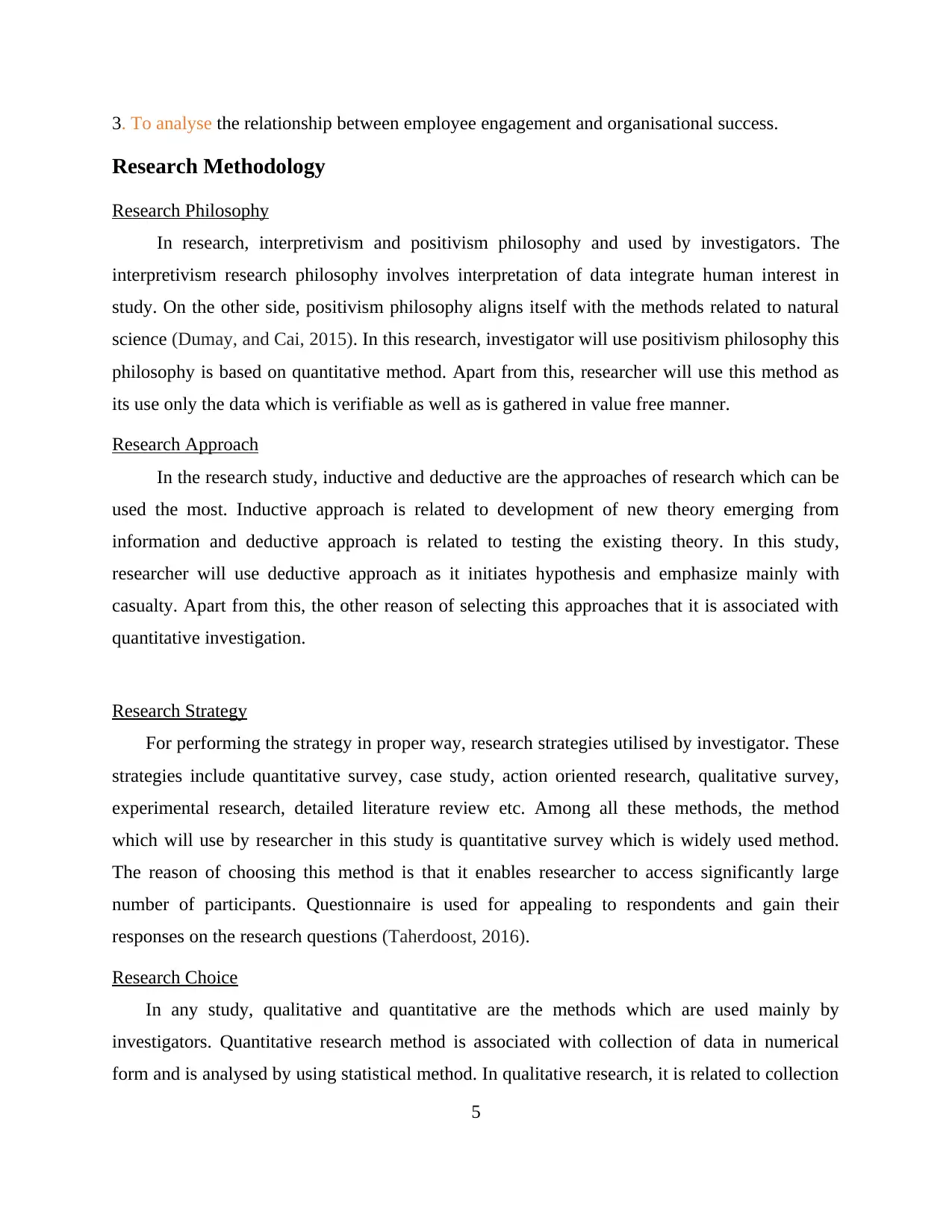
3. To analyse the relationship between employee engagement and organisational success.
Research Methodology
Research Philosophy
In research, interpretivism and positivism philosophy and used by investigators. The
interpretivism research philosophy involves interpretation of data integrate human interest in
study. On the other side, positivism philosophy aligns itself with the methods related to natural
science (Dumay, and Cai, 2015). In this research, investigator will use positivism philosophy this
philosophy is based on quantitative method. Apart from this, researcher will use this method as
its use only the data which is verifiable as well as is gathered in value free manner.
Research Approach
In the research study, inductive and deductive are the approaches of research which can be
used the most. Inductive approach is related to development of new theory emerging from
information and deductive approach is related to testing the existing theory. In this study,
researcher will use deductive approach as it initiates hypothesis and emphasize mainly with
casualty. Apart from this, the other reason of selecting this approaches that it is associated with
quantitative investigation.
Research Strategy
For performing the strategy in proper way, research strategies utilised by investigator. These
strategies include quantitative survey, case study, action oriented research, qualitative survey,
experimental research, detailed literature review etc. Among all these methods, the method
which will use by researcher in this study is quantitative survey which is widely used method.
The reason of choosing this method is that it enables researcher to access significantly large
number of participants. Questionnaire is used for appealing to respondents and gain their
responses on the research questions (Taherdoost, 2016).
Research Choice
In any study, qualitative and quantitative are the methods which are used mainly by
investigators. Quantitative research method is associated with collection of data in numerical
form and is analysed by using statistical method. In qualitative research, it is related to collection
5
Research Methodology
Research Philosophy
In research, interpretivism and positivism philosophy and used by investigators. The
interpretivism research philosophy involves interpretation of data integrate human interest in
study. On the other side, positivism philosophy aligns itself with the methods related to natural
science (Dumay, and Cai, 2015). In this research, investigator will use positivism philosophy this
philosophy is based on quantitative method. Apart from this, researcher will use this method as
its use only the data which is verifiable as well as is gathered in value free manner.
Research Approach
In the research study, inductive and deductive are the approaches of research which can be
used the most. Inductive approach is related to development of new theory emerging from
information and deductive approach is related to testing the existing theory. In this study,
researcher will use deductive approach as it initiates hypothesis and emphasize mainly with
casualty. Apart from this, the other reason of selecting this approaches that it is associated with
quantitative investigation.
Research Strategy
For performing the strategy in proper way, research strategies utilised by investigator. These
strategies include quantitative survey, case study, action oriented research, qualitative survey,
experimental research, detailed literature review etc. Among all these methods, the method
which will use by researcher in this study is quantitative survey which is widely used method.
The reason of choosing this method is that it enables researcher to access significantly large
number of participants. Questionnaire is used for appealing to respondents and gain their
responses on the research questions (Taherdoost, 2016).
Research Choice
In any study, qualitative and quantitative are the methods which are used mainly by
investigators. Quantitative research method is associated with collection of data in numerical
form and is analysed by using statistical method. In qualitative research, it is related to collection
5
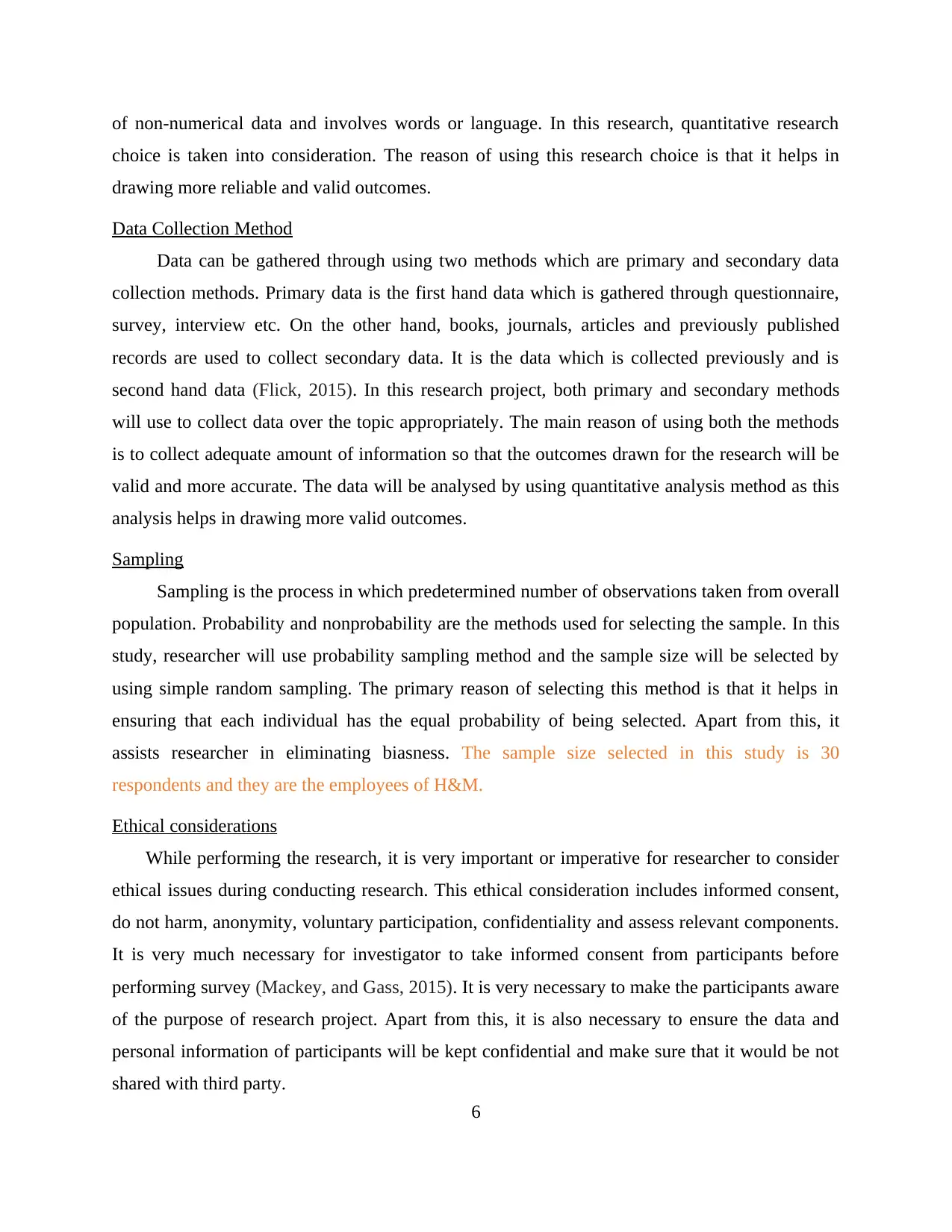
of non-numerical data and involves words or language. In this research, quantitative research
choice is taken into consideration. The reason of using this research choice is that it helps in
drawing more reliable and valid outcomes.
Data Collection Method
Data can be gathered through using two methods which are primary and secondary data
collection methods. Primary data is the first hand data which is gathered through questionnaire,
survey, interview etc. On the other hand, books, journals, articles and previously published
records are used to collect secondary data. It is the data which is collected previously and is
second hand data (Flick, 2015). In this research project, both primary and secondary methods
will use to collect data over the topic appropriately. The main reason of using both the methods
is to collect adequate amount of information so that the outcomes drawn for the research will be
valid and more accurate. The data will be analysed by using quantitative analysis method as this
analysis helps in drawing more valid outcomes.
Sampling
Sampling is the process in which predetermined number of observations taken from overall
population. Probability and nonprobability are the methods used for selecting the sample. In this
study, researcher will use probability sampling method and the sample size will be selected by
using simple random sampling. The primary reason of selecting this method is that it helps in
ensuring that each individual has the equal probability of being selected. Apart from this, it
assists researcher in eliminating biasness. The sample size selected in this study is 30
respondents and they are the employees of H&M.
Ethical considerations
While performing the research, it is very important or imperative for researcher to consider
ethical issues during conducting research. This ethical consideration includes informed consent,
do not harm, anonymity, voluntary participation, confidentiality and assess relevant components.
It is very much necessary for investigator to take informed consent from participants before
performing survey (Mackey, and Gass, 2015). It is very necessary to make the participants aware
of the purpose of research project. Apart from this, it is also necessary to ensure the data and
personal information of participants will be kept confidential and make sure that it would be not
shared with third party.
6
choice is taken into consideration. The reason of using this research choice is that it helps in
drawing more reliable and valid outcomes.
Data Collection Method
Data can be gathered through using two methods which are primary and secondary data
collection methods. Primary data is the first hand data which is gathered through questionnaire,
survey, interview etc. On the other hand, books, journals, articles and previously published
records are used to collect secondary data. It is the data which is collected previously and is
second hand data (Flick, 2015). In this research project, both primary and secondary methods
will use to collect data over the topic appropriately. The main reason of using both the methods
is to collect adequate amount of information so that the outcomes drawn for the research will be
valid and more accurate. The data will be analysed by using quantitative analysis method as this
analysis helps in drawing more valid outcomes.
Sampling
Sampling is the process in which predetermined number of observations taken from overall
population. Probability and nonprobability are the methods used for selecting the sample. In this
study, researcher will use probability sampling method and the sample size will be selected by
using simple random sampling. The primary reason of selecting this method is that it helps in
ensuring that each individual has the equal probability of being selected. Apart from this, it
assists researcher in eliminating biasness. The sample size selected in this study is 30
respondents and they are the employees of H&M.
Ethical considerations
While performing the research, it is very important or imperative for researcher to consider
ethical issues during conducting research. This ethical consideration includes informed consent,
do not harm, anonymity, voluntary participation, confidentiality and assess relevant components.
It is very much necessary for investigator to take informed consent from participants before
performing survey (Mackey, and Gass, 2015). It is very necessary to make the participants aware
of the purpose of research project. Apart from this, it is also necessary to ensure the data and
personal information of participants will be kept confidential and make sure that it would be not
shared with third party.
6
⊘ This is a preview!⊘
Do you want full access?
Subscribe today to unlock all pages.

Trusted by 1+ million students worldwide
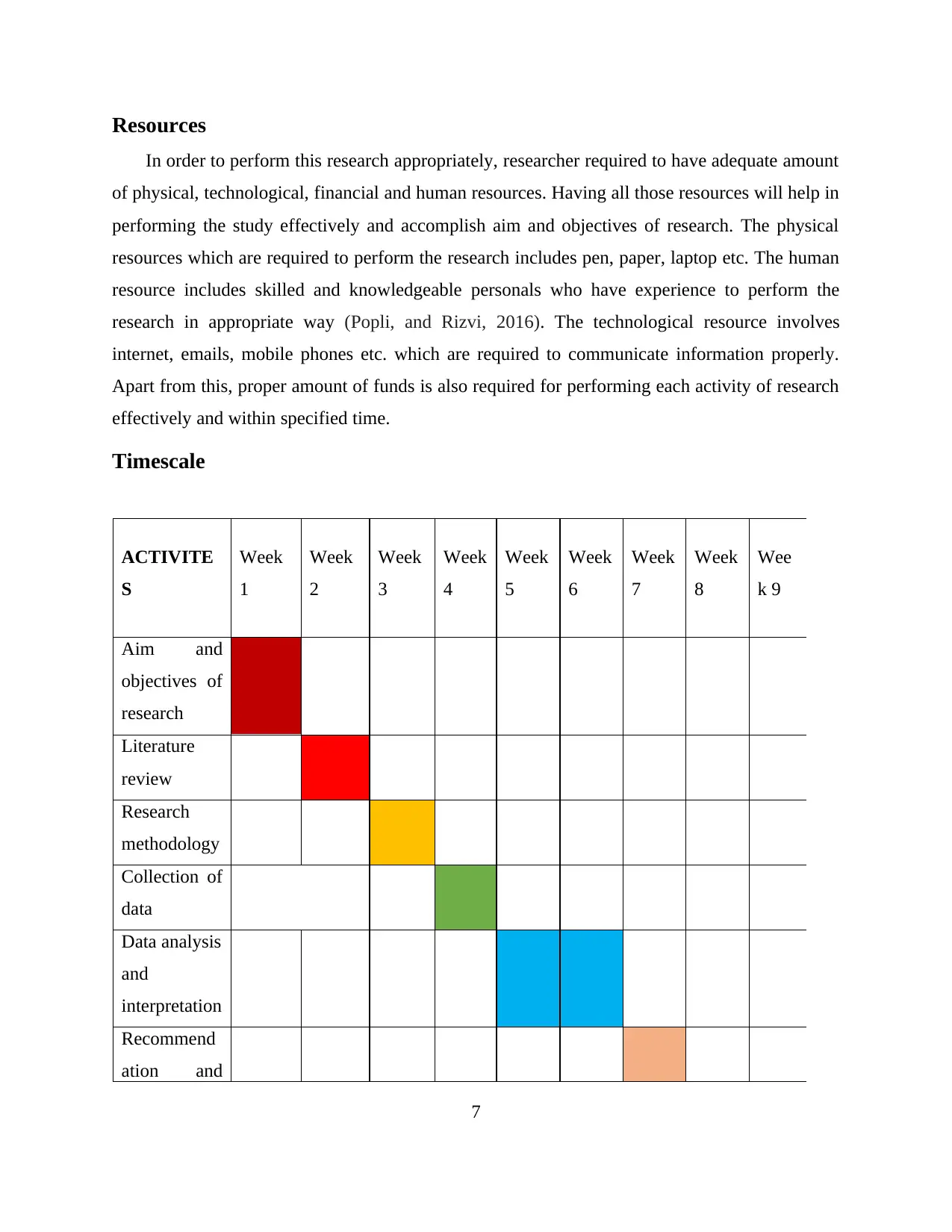
Resources
In order to perform this research appropriately, researcher required to have adequate amount
of physical, technological, financial and human resources. Having all those resources will help in
performing the study effectively and accomplish aim and objectives of research. The physical
resources which are required to perform the research includes pen, paper, laptop etc. The human
resource includes skilled and knowledgeable personals who have experience to perform the
research in appropriate way (Popli, and Rizvi, 2016). The technological resource involves
internet, emails, mobile phones etc. which are required to communicate information properly.
Apart from this, proper amount of funds is also required for performing each activity of research
effectively and within specified time.
Timescale
ACTIVITE
S
Week
1
Week
2
Week
3
Week
4
Week
5
Week
6
Week
7
Week
8
Wee
k 9
Aim and
objectives of
research
Literature
review
Research
methodology
Collection of
data
Data analysis
and
interpretation
Recommend
ation and
7
In order to perform this research appropriately, researcher required to have adequate amount
of physical, technological, financial and human resources. Having all those resources will help in
performing the study effectively and accomplish aim and objectives of research. The physical
resources which are required to perform the research includes pen, paper, laptop etc. The human
resource includes skilled and knowledgeable personals who have experience to perform the
research in appropriate way (Popli, and Rizvi, 2016). The technological resource involves
internet, emails, mobile phones etc. which are required to communicate information properly.
Apart from this, proper amount of funds is also required for performing each activity of research
effectively and within specified time.
Timescale
ACTIVITE
S
Week
1
Week
2
Week
3
Week
4
Week
5
Week
6
Week
7
Week
8
Wee
k 9
Aim and
objectives of
research
Literature
review
Research
methodology
Collection of
data
Data analysis
and
interpretation
Recommend
ation and
7
Paraphrase This Document
Need a fresh take? Get an instant paraphrase of this document with our AI Paraphraser
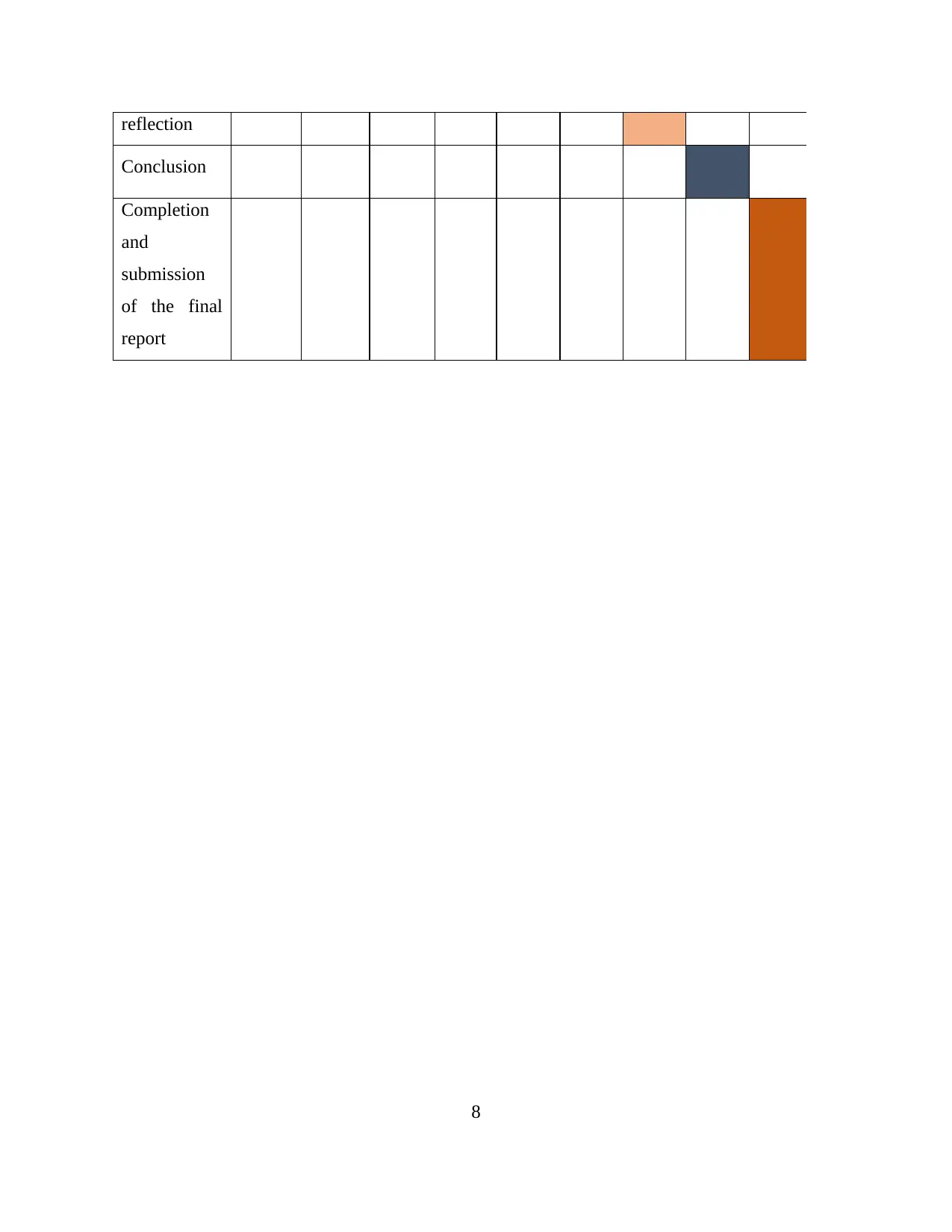
reflection
Conclusion
Completion
and
submission
of the final
report
8
Conclusion
Completion
and
submission
of the final
report
8
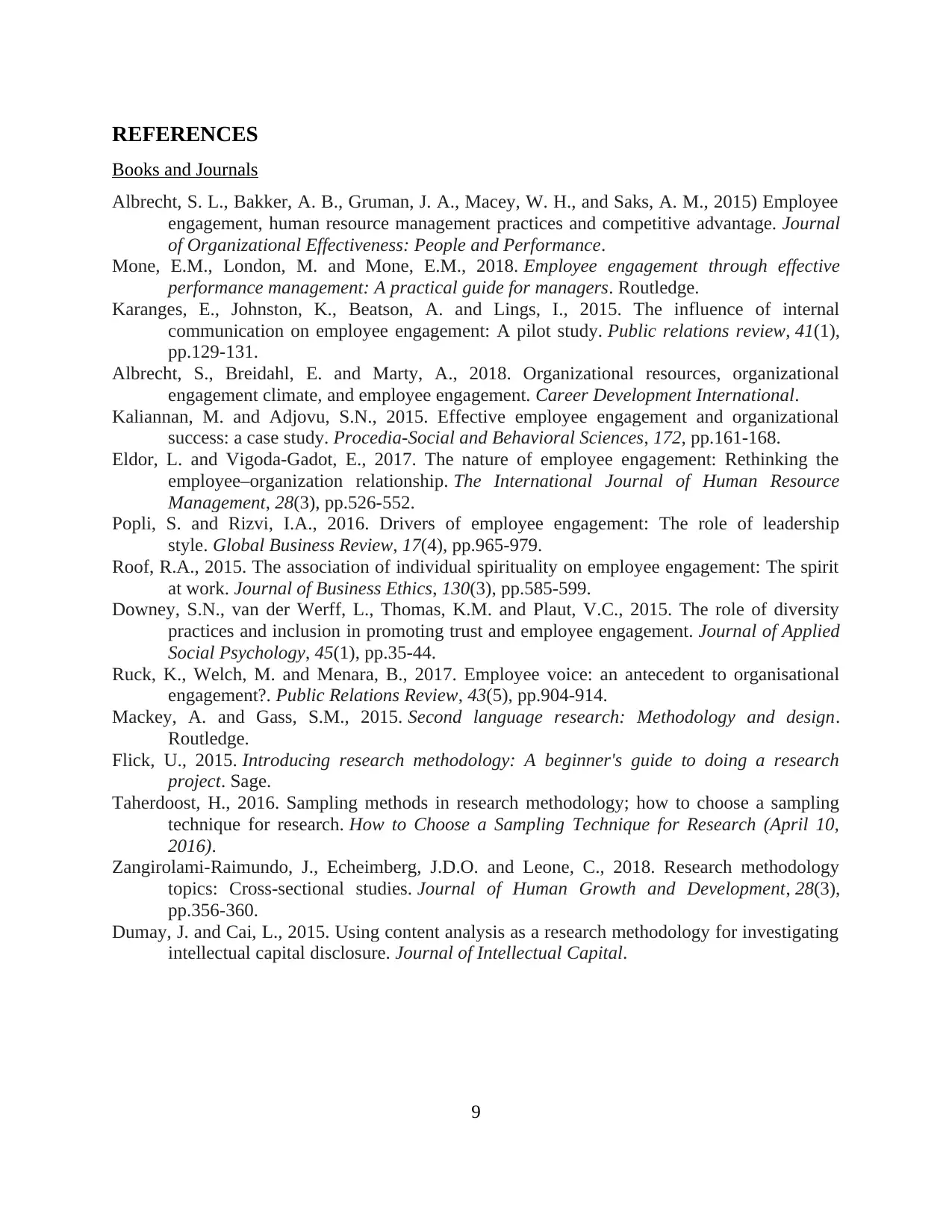
REFERENCES
Books and Journals
Albrecht, S. L., Bakker, A. B., Gruman, J. A., Macey, W. H., and Saks, A. M., 2015) Employee
engagement, human resource management practices and competitive advantage. Journal
of Organizational Effectiveness: People and Performance.
Mone, E.M., London, M. and Mone, E.M., 2018. Employee engagement through effective
performance management: A practical guide for managers. Routledge.
Karanges, E., Johnston, K., Beatson, A. and Lings, I., 2015. The influence of internal
communication on employee engagement: A pilot study. Public relations review, 41(1),
pp.129-131.
Albrecht, S., Breidahl, E. and Marty, A., 2018. Organizational resources, organizational
engagement climate, and employee engagement. Career Development International.
Kaliannan, M. and Adjovu, S.N., 2015. Effective employee engagement and organizational
success: a case study. Procedia-Social and Behavioral Sciences, 172, pp.161-168.
Eldor, L. and Vigoda-Gadot, E., 2017. The nature of employee engagement: Rethinking the
employee–organization relationship. The International Journal of Human Resource
Management, 28(3), pp.526-552.
Popli, S. and Rizvi, I.A., 2016. Drivers of employee engagement: The role of leadership
style. Global Business Review, 17(4), pp.965-979.
Roof, R.A., 2015. The association of individual spirituality on employee engagement: The spirit
at work. Journal of Business Ethics, 130(3), pp.585-599.
Downey, S.N., van der Werff, L., Thomas, K.M. and Plaut, V.C., 2015. The role of diversity
practices and inclusion in promoting trust and employee engagement. Journal of Applied
Social Psychology, 45(1), pp.35-44.
Ruck, K., Welch, M. and Menara, B., 2017. Employee voice: an antecedent to organisational
engagement?. Public Relations Review, 43(5), pp.904-914.
Mackey, A. and Gass, S.M., 2015. Second language research: Methodology and design.
Routledge.
Flick, U., 2015. Introducing research methodology: A beginner's guide to doing a research
project. Sage.
Taherdoost, H., 2016. Sampling methods in research methodology; how to choose a sampling
technique for research. How to Choose a Sampling Technique for Research (April 10,
2016).
Zangirolami-Raimundo, J., Echeimberg, J.D.O. and Leone, C., 2018. Research methodology
topics: Cross-sectional studies. Journal of Human Growth and Development, 28(3),
pp.356-360.
Dumay, J. and Cai, L., 2015. Using content analysis as a research methodology for investigating
intellectual capital disclosure. Journal of Intellectual Capital.
9
Books and Journals
Albrecht, S. L., Bakker, A. B., Gruman, J. A., Macey, W. H., and Saks, A. M., 2015) Employee
engagement, human resource management practices and competitive advantage. Journal
of Organizational Effectiveness: People and Performance.
Mone, E.M., London, M. and Mone, E.M., 2018. Employee engagement through effective
performance management: A practical guide for managers. Routledge.
Karanges, E., Johnston, K., Beatson, A. and Lings, I., 2015. The influence of internal
communication on employee engagement: A pilot study. Public relations review, 41(1),
pp.129-131.
Albrecht, S., Breidahl, E. and Marty, A., 2018. Organizational resources, organizational
engagement climate, and employee engagement. Career Development International.
Kaliannan, M. and Adjovu, S.N., 2015. Effective employee engagement and organizational
success: a case study. Procedia-Social and Behavioral Sciences, 172, pp.161-168.
Eldor, L. and Vigoda-Gadot, E., 2017. The nature of employee engagement: Rethinking the
employee–organization relationship. The International Journal of Human Resource
Management, 28(3), pp.526-552.
Popli, S. and Rizvi, I.A., 2016. Drivers of employee engagement: The role of leadership
style. Global Business Review, 17(4), pp.965-979.
Roof, R.A., 2015. The association of individual spirituality on employee engagement: The spirit
at work. Journal of Business Ethics, 130(3), pp.585-599.
Downey, S.N., van der Werff, L., Thomas, K.M. and Plaut, V.C., 2015. The role of diversity
practices and inclusion in promoting trust and employee engagement. Journal of Applied
Social Psychology, 45(1), pp.35-44.
Ruck, K., Welch, M. and Menara, B., 2017. Employee voice: an antecedent to organisational
engagement?. Public Relations Review, 43(5), pp.904-914.
Mackey, A. and Gass, S.M., 2015. Second language research: Methodology and design.
Routledge.
Flick, U., 2015. Introducing research methodology: A beginner's guide to doing a research
project. Sage.
Taherdoost, H., 2016. Sampling methods in research methodology; how to choose a sampling
technique for research. How to Choose a Sampling Technique for Research (April 10,
2016).
Zangirolami-Raimundo, J., Echeimberg, J.D.O. and Leone, C., 2018. Research methodology
topics: Cross-sectional studies. Journal of Human Growth and Development, 28(3),
pp.356-360.
Dumay, J. and Cai, L., 2015. Using content analysis as a research methodology for investigating
intellectual capital disclosure. Journal of Intellectual Capital.
9
⊘ This is a preview!⊘
Do you want full access?
Subscribe today to unlock all pages.

Trusted by 1+ million students worldwide
1 out of 9
Related Documents
Your All-in-One AI-Powered Toolkit for Academic Success.
+13062052269
info@desklib.com
Available 24*7 on WhatsApp / Email
![[object Object]](/_next/static/media/star-bottom.7253800d.svg)
Unlock your academic potential
Copyright © 2020–2025 A2Z Services. All Rights Reserved. Developed and managed by ZUCOL.





